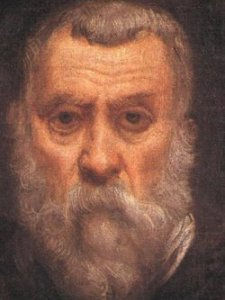(Venice 1518-1594)
Tintoretto or Jacopo Tintoretto, whose real name was Jacopo Comin, was one of the great painters of the Venetian school and one of the last of the Italian Renaissance.
The Italian painter was a disciple of Titian and Paris Bordone, but he was also inspired by the tormented style of Pordenone and the unrealism of Schiavone. A trip to Rome (1545-1546), which brought him into contact with Michelangelo and the Mannerists, definitively oriented his art towards dramatic expression and great effects of light. His artistic career developed in Venice, where he painted his first major works: The Last Supper (1547, San Marcuola) and The Miracle of the Slave (1548, Academy). Endowed with surprising virtuosity, his work approaches that of Titian and at times Veronese.
Tintoretto used all the resources of Mannerism: his figures twist and writhe; the light effects offer strong contrasts, and his compositions are arranged in large diagonals, creating the impression of extending through infinite spaces (Saint Augustine Healing the Plague Victims, Vienna).
For the Scuola di San Rocco, whose complete decoration is attributed to him (1546-1587), he executed a series of fifty-six compositions: some scenes from the life of Saint Roch, and a cycle from the New Testament, where the dramatic force of his style is brilliantly manifested.
Another set of his masterpieces is found in the Doge's Palace: decoration of the Hall of the College, the Hall of the Senate (in which he represented Venice, Queen of the Seas, 1582), and the Hall of the Great Council, for which he painted the enormous canvas of The Glory of the Chosen or Paradise (1588), a celestial vision of the chosen ones, arranged in large concentric circles.
He also created numerous portraits of Venetian figures, characterized by the contrast of their light faces against the dark background of the canvas: Alvise Barbaro (Florence, Pitti Palace), Jacopo Soranzo (Milan), Battista Morosini (Florence, Academy). His drawings, nervous and rough, demonstrate that he used, as preparation for his large compositions, small models vigorously illuminated. Tintoretto's influence was strongly projected in the evolution of European Mannerism in the second half of the century, and particularly in the formation of El Greco.
His works can be found in the most important museums in the world.
Tintoretto or Jacopo Tintoretto, whose real name was Jacopo Comin, was one of the great painters of the Venetian school and one of the last of the Italian Renaissance.
The Italian painter was a disciple of Titian and Paris Bordone, but he was also inspired by the tormented style of Pordenone and the unrealism of Schiavone. A trip to Rome (1545-1546), which brought him into contact with Michelangelo and the Mannerists, definitively oriented his art towards dramatic expression and great effects of light. His artistic career developed in Venice, where he painted his first major works: The Last Supper (1547, San Marcuola) and The Miracle of the Slave (1548, Academy). Endowed with surprising virtuosity, his work approaches that of Titian and at times Veronese.
Tintoretto used all the resources of Mannerism: his figures twist and writhe; the light effects offer strong contrasts, and his compositions are arranged in large diagonals, creating the impression of extending through infinite spaces (Saint Augustine Healing the Plague Victims, Vienna).
For the Scuola di San Rocco, whose complete decoration is attributed to him (1546-1587), he executed a series of fifty-six compositions: some scenes from the life of Saint Roch, and a cycle from the New Testament, where the dramatic force of his style is brilliantly manifested.
Another set of his masterpieces is found in the Doge's Palace: decoration of the Hall of the College, the Hall of the Senate (in which he represented Venice, Queen of the Seas, 1582), and the Hall of the Great Council, for which he painted the enormous canvas of The Glory of the Chosen or Paradise (1588), a celestial vision of the chosen ones, arranged in large concentric circles.
He also created numerous portraits of Venetian figures, characterized by the contrast of their light faces against the dark background of the canvas: Alvise Barbaro (Florence, Pitti Palace), Jacopo Soranzo (Milan), Battista Morosini (Florence, Academy). His drawings, nervous and rough, demonstrate that he used, as preparation for his large compositions, small models vigorously illuminated. Tintoretto's influence was strongly projected in the evolution of European Mannerism in the second half of the century, and particularly in the formation of El Greco.
His works can be found in the most important museums in the world.


